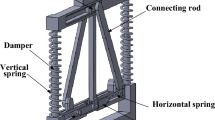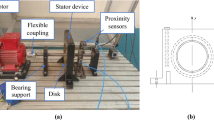Abstract
This paper researched the synchronous characteristic of three homodromy motors in a secondary isolation system. Firstly, the motion differential equations of the system were established via employing Lagrange’s equation. The Laplace transform was used to deduce approximate solutions of displacement. Next, the ability of vibrating isolation was determined through amplitude ratio. Secondly, the synchronous condition and steady criterion was obtained via employing the average small parameters method and Lyapunov criterion. And then the influence of structural parameters of the system on synchronous ability was analyzed. Moreover, the synchronous characteristics of the system, including the difference of residual torque among induction motors, the synchronous ability, the output torque of motors and the stable phase difference, were discussed through numerical analyses. Finally, the accuracy of theoretical analyses was proved through computer simulation results. It is shown that, the ability of vibrating isolation is principally impacted by vertical spring stiffness; the greater the installation distance among three motors, the easier to achieve synchronous motion of the rotors; meanwhile, the output torque of asynchronous motors is affected by the synchronous state of the vibrating system; the synchronous characteristic is mainly affected by the mounting dip angle of motors and the installation distance among motors. The research results can promote development of vibration engineering and related fields.
Similar content being viewed by others
Abbreviations
- m i :
-
Mass of the asynchronous motor i, i = 1, 2, 3
- M 1 :
-
Mass of the vibration body
- M 2 :
-
Mass of the isolation body
- k i :
-
Stiffness coefficient of the vibrating system in i- DOFs, i = x1, x2, y1, y2, ψ1, ψ2
- f i :
-
Damping coefficient of the vibrating system in i- DOFs, i = x1, x2, y1, y2, ψ1, ψ2
- x i :
-
Displacement response of the vibrating system in xi-DOFs, i = 1, 2
- y i :
-
Displacement response of the vibrating system in yi-DOFs, i =1, 2
- ψ i :
-
Rotation response of the vibrating system in ψi — DOFs, i = 1, 2
- r :
-
Eccentric radius of the unbalance rotors
- β i :
-
Inclined angle among \(o_1^\prime {o_{11}}\) (\(o_1^\prime {o_{12}}\), \(o_1^\prime {o_{13}}\)) and \(o_1^\prime x\), i = 1, 2, 3
- l i :
-
Distance between the driving axis of asynchronous motor i and the centroid of the vibration body, i = 1, 2, 3
- φ :
-
Average phase angle of three unbalance rotors
- φ i :
-
Phase angle of the unbalance rotor i, i = 1, 2, 3
- \({\dot \varphi _i}\) :
-
Angular velocity of the unbalance rotor i, i = 1, 2, 3
- \({\ddot \varphi _i}\) :
-
Angular acceleration of the unbalance rotor i, i = 1, 2, 3
- ε i :
-
Self-defined instantaneous fluctuation coefficient of angular velocity of the unbalance rotor i, i = 1, 2, 3
- J 1 :
-
Rotation inertia of the vibration body around its centroid
- J 2 :
-
Rotation inertia of the isolation body around its centroid
- J0i :
-
Rotation inertia of the asynchronous motor i, i = 1, 2, 3
- T ei :
-
Torque of the asynchronous motor i, i = 1, 2, 3
- T 0i :
-
Output torque of the asynchronous motor i, i = 1, 2, 3
- M :
-
Self-defined mass sum of the vibration body and three motors, M = M1 + m0 + m1 + m2
- ω m0 :
-
Average angular velocity of asynchronous motors
- 2α i :
-
Phase difference among the unbalance rotors, i = 1, 2, 3
- l e :
-
Eccentricity radius of the vibration body and IB, \({J_1} = MI_e^2\), \({J_2} = {M_2}I_e^2\)
- ω i :
-
Natural frequency of the system in i DOFs, i = x1, x2, y1, y2, ψ1, ψ2
- η i :
-
Mass ratio, i = 1,2,3,4, η1 = m1/M, η2 = m2/M, η3 = m3/M, η4 = M/M2
- r l :
-
rl = l/le
- η i :
-
Frequency ratio of the system in i-DOFs, i = x1, x2, y1, y2, ψ1, ψ2
- ξ i :
-
Damping ratio of the system in i1- DOFs, i = x1, x2, y1, y2, ψ1, ψ2
- u j :
-
Coupling coefficient of the system in j direction, j = x1, x2, y1, y2, ψ1, ψ2
- γ j :
-
Lagging angle of phase in j direction, j = x1, x2, y1, y2, ψ1, ψ2
- δ :
-
Coefficient of isolation ability
- W s0 :
-
Sine coefficients of lagging phase
- Ws cij :
-
Sine coefficients of lagging phase, i = 1,2; i < j ≤ 3
- W c0 :
-
Cosine coefficients of lagging phase
- W ccij cc j :
-
Cosine coefficients of lagging phase, i = 1,2; i < j ≤ 3
- ΔT 012 :
-
Difference value of output torque between asynchronous motor 1 and 2
- ΔT 023 :
-
Difference value of output torque between asynchronous motor 2 and 3
- T d12 :
-
Difference value of dimensionless residual torque between asynchronous motor 1 and 2
- T d23 :
-
Difference value of dimensionless residual torque between asynchronous motor 2 and 3
- ζ i :
-
Coefficient of synchronous ability, i = 12, 13, 23
- I :
-
Unit matrix
- (●)0 :
-
Represents the values for \({\overline \alpha _1} = {\overline \alpha _{10}},{\overline \alpha _2} = {\overline \alpha _{20}}\)
References
P. Khanchandani and C. Lenzen, Self-stabilizing byzantine clock synchronization with optimal precision, Theory of Computing Systems, 63(2) (2019) 261–305.
P. Fang, Q. Yang, Y. Hou and Y. Chen, Theoretical study on self-synchronization of two homodromy rotors coupled with a pendulum rod in a far-resonant vibrating system, Journal of Vibroengineering, 16(5) (2014) 2188–2204.
F. Huawei, W. Yafeng, W. Hengtong, L. Yingcheng and W. Xingang, Autapses promote synchronization in neuronal networks, Scientific Reports, 8(1) (2018) 580.
R. Yamapi and P. Woafo, Dynamics and synchronization of coupled self-sustained electromechanical devices, Journal of Sound and Vibration, 285(4–5) (2005) 1151–1170.
I. I. Blekhman, Selected Topics in Vibrational Mechanics, World Scientific, Singapore (2004).
L. Sperling, B. Ryzhik and C. Linz, Simulation of two-plane automatic balancing of a rigid rotor, Mathematics and Computers in Simulation, 58(4) (2002) 351–365.
B. C. Wen, J. Fan and C. Y. Zhao, Synchronization and Controlled Synchronization in Engineering, Science Press, Beijing, China (2009).
C. Y. Zhao, B. C. Wen and X. L. Zhang, Synchronization of the four identical unbalanced rotors in a vibrating system of plane motion, Science China Technological Sciences, 53(2) (2010) 405–422.
X. L. Zhang, B. C. Wen and C. Y. Zhao, Synchronization of three non-identical coupled exciters with the same rotating directions in a far-resonant vibrating system, Journal of Sound and Vibration, 332(9) (2013) 2300–2317.
X. L. Zhang, B. C. Wen and C. Y. Zhao, Theoretical, numerical and experimental study on synchronization of three identical exciters in a vibrating system, Chinese Journal of Mechanical Engineering, 26(4) (2013) 746–757.
X. L. Zhang, B. C. Wen and C. Y. Zhao, Vibratory synchronization and coupling dynamic characteristics of multiple unbalanced rotors on a mass-spring rigid base, International Journal of Non-Linear Mechanics, 60 (2014) 1–8.
P. Fang and Y. J. Hou, Synchronization characteristics of a rotorpendula system in multiple coupling resonant systems, Proceedings of the Institution of Mechanical Engineers, Part C: Journal of Mechanical Engineering Science, 232(10) (2018) 1802–1822.
Y. J. Hou and P. Fang, Investigation for synchronization of a rotor-pendulum system considering the multi-DOF vibration, Shock and Vibration (2016) 1–22.
P. Fang, Y. J. Hou and M. J. Du, Synchronization behavior of triple-rotor-pendula system in a dual-super-far resonance system, Proceedings of the Institution of Mechanical Engineers, 233(5) (2019) 1620–1640.
Y. J. Hou, M. J. Du, P. Fang, Y. W. Wang and L. P. Zhang, Synchronization and stability of elasticity coupling two homodromy rotors in a vibration system, Shock and Vibration (2016) 1–11.
Y. J. Hou, M. J. Du, P. Fang and L. P. Zhang, Synchronization and stability of an elastically coupled tri-rotor vibration system, Journal of Theoretical and Applied Mechanics, 55(1) (2017) 227–240.
X. X. Kong, X. L. Zhang, X. Z. Chen, B. C. Wen and B. Wang, Phase and speed synchronization control of four eccentric rotors driven by induction motors in a linear vibratory feeder with unknown time-varying load torques using adaptive sliding mode control algorithm, Journal of Sound and Vibration, 370 (2016) 23–42.
X. X. Kong, X. Z. Chen and B. C. Wen, Composite synchronization of three eccentric rotors driven by induction motors in a vibrating system, Mechanical Systems and Signal Processing, 102 (2018) 158–179.
H. Li, D. Liu, L. Jiang, C. Y. Zhao and B. C. Wen, Self-synchronization theory of a vibrating system with a two-stage vibration isolation frame driven by two motors, Journal of Vibration and Shock, 33 (2014) 134–140.
J. T. Liu, X. H. Li, H. B. Gao and J. Liu, Theory and application of the double-mass anti-vibration isolation vibrating machine, Advanced Science Letters, 4(6–7) (2011) 2400–2404.
J. Liu, C. Jiao, X. Li, Y. Li and J. Liu, Dynamic parameters selection method and simulation of the anti-resonance vibration machine, Computer and Automation Engineering (ICCAE), 4 (2010) 457–462.
M. Zou, P. Fang, Y. J. Hou, Y. G. Wang, D. Y. Hou and H. Peng, Synchronization analysis of two eccentric rotors with double-frequency excitation considering sliding mode control, Communications in Nonlinear Science and Numerical Simulation, 92 (2019) 105458.
Acknowledgments
This research is based on National Natural Science Foundation of China (Grant No. 51705437), the Chinese Postdoctoral Fund (No. 2019M653482), the Chengdu International Science and Technology Cooperation Project (No. 2019-GH02-00035-HZ), supported by Sichuan Science and Technology Program (No. 2020YFG0181). Sichuan Science and Technology Innovation Cultivation Project (No. 2020038).
Author information
Authors and Affiliations
Corresponding author
Additional information
Yongjun Hou completed his Ph.D. in Mechanical Engineering from Southwest Petroleum University, China, in 2002. Presently he is a Professor at Southwest Petroleum University, China. His research interests include petroleum drilling solids control systems.
Han Peng is currently pursuing a Doctoral degree at School of Mechanical Engineering, Southwest Petroleum University, China. His research interests include dynamics of multi-body systems, synchronization of vibration systems.
Pan Fang completed his Ph.D. in Mechanical Engineering from Southwest Petroleum University, China, in 2016. Presently he is a Master Tutor at Southwest Petroleum University, China. His research interests include dynamics of multi-body systems and vibration control.
Rights and permissions
About this article
Cite this article
Hou, Y., Peng, H., Fang, P. et al. Synchronous characteristic of three homodromy motors in vibrating isolation system. J Mech Sci Technol 35, 45–60 (2021). https://doi.org/10.1007/s12206-020-1204-2
Received:
Revised:
Accepted:
Published:
Issue Date:
DOI: https://doi.org/10.1007/s12206-020-1204-2




